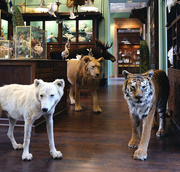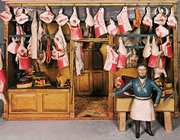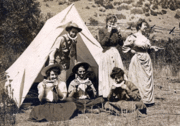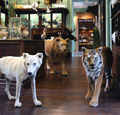
Polish chickens, which are not from Poland, were bred for their elaborate plumes and crests. This pair of Gold Spangled Polish chickens was featured in The Illustrated Book of Poultry by Lewis Wright, 1872.
During Queen Victoria’s long and productive reign, from 1837 to 1901, countless buildings, books, and pieces of furniture were erected, written, and manufactured. Though the monarch did not invent Queen Anne Revival style, pen Middlemarch, or decree that otherwise comfortable sofas should be crowned with unyielding rims of carved hardwood, causing untold bumps on untold numbers of unsuspecting noggins, we routinely classify this varied output as Victorian Architecture, Victorian Literature, and Victorian Furniture, respectively.
“Victoria fancied all sorts of animals, and the fancier the better.”
Victoria, it turns out, is actually more directly responsible for Kentucky Fried Chicken. Yes, it’s sorta true! You see, the queen and her husband, Albert, devoted a great deal of their royal time and attention to the care, feeding, and breeding of chickens, which in mid-19th-century Britain were a scrawny and not especially appetizing lot. Victoria changed all that, popularizing the raising of big and beautiful chickens, many bred with birds imported from Asia. The monarch’s interest in fancy chickens ignited what was then called “hen fever,” during which the price of a pair of chickens climbed as high as $700 (the equivalent of $24,000 in 2021) before the bubble burst in 1855.

A Buff Shanghae rooster, illustrated by Harrison Weir in The Poultry Book, 1853.
Through her fowl works, Victoria helped the world develop a taste for chicken. Victoria’s hens laid more eggs than local poultry breeds, and they were good eatin’, too. That ultimately had a direct impact on Colonel Harland Sanders, who was born in the last decade of the Victorian Era. Because a real queen had helped make chicken popular, a century or so later an honorific colonel would not need to experiment with alternative edible delivery devices for his secret blend of 11 herbs and spices. In short, Queen Victoria saved the world from Kentucky Fried Opossum.

This comical illustration of one of Queen Victoria’s Cochin China chickens, from The History of The Hen Fever: A Humorous Record by George P. Burnham, 1855, shows why the birds were referred to as Ostrich Fowl.
Andrew Lawler would not make such a claim. As the author of the meticulously footnoted Why Did the Chicken Cross the World? (Atria Books, 2016), Lawler is obliged to stick more closely to the facts than I am. Still, the facts pertaining to the queen’s degrees of separation from the colonel litter Lawler’s thoroughly engaging book, beginning with Victoria’s receipt, in 1842, of five hens and two roosters. Unlike the comparatively small and plain chickens that pecked and squawked in most U.K. hen houses, Victoria’s Cochin China or Shanghae chickens, as they were variously called, were almost ornamental. Illustrations of Shanghae (the Victorian Era spelling of Shanghai) fowl from 1853 corroborate the descriptions of these birds as having long yellowish legs, ample bodies, and russet-colored feathers that give way to black tails on the roosters. Curiously, though, the press dubbed these exotic creatures “ostrich fowl,” which suggests that at least some of Victoria’s chickens may have been a breed known as the Malay, which unlike Cochin China or Shanghae chickens could easily be caricatured by a clever editorial cartoonist as an ostrich.
“People in Britain at that time didn’t understand the geography of Southeast Asia and China,” Lawler tells me over the phone. “Even if a sailor had gone ashore in Indonesia and brought some chickens aboard there, those same chickens might be identified at the dock in London as ‘Chinese’ chickens. ‘China’ was often used as a generic word for ‘The East.’ It was not a specific term meaning a specific place but a regional idea about that part of the world.”

At least some of the hens and roosters delivered to Queen Victoria in 1842 may have been Malays, which more closely resemble the caricatures of Ostrich Fowl than do the Cochin China and Shanghae chickens she also raised.
The story of the chicken’s ubiquity in “The West” begins in 1841 in China—the actual place—toward the end of the Opium War, an imperialistic dust up in which the sovereignty of one nation was ignored in favor of the colonial ambitions of another. For reasons that arguably should not have mattered to anyone but the Chinese, the purchase of fine porcelain, silk, and tea by Westerners had been limited since the 17th century to just a couple of times a year, and only in a few southern ports, including Guangzhou, then called Canton. In exchange for these goods, the Chinese reasonably required payment in silver, which quickly caused a trade imbalance with the acquisitive British. By the late 18th century, the British East India Company had hatched a plan to correct this deficit by cultivating opium in Bengal, which was then a part of British India. Though opium was illegal in China due to its corrosive effect on the population, the Brits began selling their Bengali opium to Chinese blackmarketeers, who paid for the drug in—you guessed it—silver.
Not surprisingly, the Chinese were not pleased by all this British-supplied opium flooding into their country. And so, in 1839, in a variation of the Boston Tea Party, the Chinese seized and destroyed thousands of cases of British opium. In retrospect, this sounds like an act of self defense against an illegal and immoral breach of China’s borders. Naturally, the British didn’t see it that way, sending troops onto the mainland and warships into the China Seas.

Queen Victoria got her exotic chickens from a naval commander named Edward Belcher, whose reputation was so bad, the world’s most poisonous reptile was named after him during his lifetime.
A couple of those warships were commanded by Captain Edward Belcher, who had left England in 1836 aboard the HMS Sulphur for a circumnavigation of the globe. Belcher left the same year Charles Darwin returned home after his five-year voyage aboard the HMS Beagle, which carried him to the Galapagos Islands, where he studied his famous finches in the fall of 1835. Belcher was widely disliked by his crews, while his popularity at home was hardly much better. In fact, his wife, Diana, accused him of knowingly infecting her with venereal disease on their wedding night, a charge that was corroborated in court when she sued him for the Victorian equivalent of divorce—it was not granted, but Diana left the cad anyway. Apparently, giving his wife VD was just one of many reasons why the world’s deadliest reptile, a poisonous sea snake, was named after Belcher—not after his death so he couldn’t take offense, but while he was still alive.
Which brings us back to 1841 and chickens. By then, Belcher had interrupted his around-the-world voyage to command a pair of warships, whose firepower was enough to sink an entire fleet of Chinese vessels in the strategic Pearl River Delta. After that victory, Belcher seized the deep-water port of Hong Kong in the name of Queen Victoria, who had assumed the throne at age 18 in 1837, just one year after Belcher had left England.

One of the many specimens Belcher acquired for the British Museum during his travels was a Red Jungle Fowl, a wild Southeast Asian bird thought to be the evolutionary forebear of all domesticated chickens.
On August 29, 1842, the Treaty of Nanking was signed, eventually delivering Hong Kong to the British Empire on June 23, 1843. Coincidentally, Belcher returned to London that same August of 1842. On his way home, he stopped at numerous ports of call for supplies, as well as to collect flora and fauna for the British Museum. Among the many specimens he collected was a male Red Jungle Fowl, which would soon be shown to be an evolutionary forebear of the chicken. Belcher also stopped at a harbor on the northern tip of Sumatra, where, according to his captain’s log, he purchased some poultry.
Lawler believes these Sumatran birds are the ones that found their way into Victoria’s royal hen house. “There’s no way to know,” he cautions, “but there’s no better evidence that we have or likely will have. Given the description of these chickens,” he adds, “they seem to fit more with the Sumatran birds of that era than the Chinese birds.”
Wherever they came from, in September 1842, Belcher had the aforementioned five hens and two roosters presented to the queen, his reputation being so poor, even after the seizure of Hong Kong, that propriety precluded him from handing over the foreign fowl to her majesty himself.

Queen Victoria’s poultry house, circa 1850s.
Victoria fancied all sorts of animals, and the fancier the better. As queen, Lawler writes, she was thrilled by the “lions, tigers, and leopards,” which she described as “barbaric offerings” when they were presented to her as gifts from “tropical princes.” In turn, she gifted these animals to the London Zoo, which she regularly visited.
Albert, too, was fond of animals, particularly birds. After the couple married in 1840, they set to work finding a site for, and then building, an aviary, which was expanded to include a grand poultry house after the arrival of the Sumatran chickens.
Even before Victoria and Albert had completed their very fancy chicken coop for their new exotic birds, the royal poultry keeper, James Walter, began breeding them with the ancestors of the Dorking chickens that had been brought to the British Isles by the Romans in the 1st century. Thanks to Walter’s work with the queen’s flock, in 1846, as potato famine strangled Ireland, Victoria and Albert were able to send three hens and a rooster crossbred from the descendants of Belcher’s original Sumatran birds to Dublin in the hopes that the offspring of these bigger, higher-egg-producing chickens might help feed a starving nation.

Until 1842, the Dorking ruled British chicken yards. By 1853 when this one was illustrated, interbreeding with Asian chickens had made the once scrawny Dorking a substantial bird.
By 1849, descendants of those same chickens had made their way to the eastern United States. There, the rise in the price of prized poultry paralleled the cost of picks and shovels out west, where the California Gold Rush was already in progress. While the price of poultry would eventually abate, crashing hard in 1855, the nation’s—indeed, the world’s—taste for chicken did not. Within four decades, in 1890, the year Harland Sanders was born, Lawler tells us that more than 280 million chickens would lay 10 billion eggs in the United States, a steep rise in the popularity of poultry compared to the beginning of the century, when chicken eggs and meat were mostly consumed by enslaved peoples, whose masters preferred ducks and geese.
Queen Victoria, an abolitionist whose title gave her an outsize influence on trends of the day, helped make chicken a food so universally associated with wholesome nourishment that within just a few decades after her death, politicians would start promising would-be voters a “chicken in every pot.” By the time KFC franchises were spreading across the nation after World War II, all Colonel Sanders had to do to sell his deep-fried breasts, wings, drumsticks, and thighs was to promise customers that his birds were so full of fat, they’d happily lick their fingers to keep the tasty grease from running down their elbows.
The crash of hen fever in 1855 made such table manners possible, for the chicken would not have become so universally consumed if its price had remained at $700 for a breeding pair. The collapse was also a boon to Charles Darwin, who was finally able to afford enough chickens to study—Darwin’s work with chickens would inform On the Origin of Species, which was published in 1859.

In his landmark work, On the Origin of Species, Charles Darwin used the domesticated chickens he acquired after the collapse of “hen fever” in 1855 to help make his case for his theory of natural selection.
“I found that to be one of the juiciest bits of my research,” Lawler says. “Darwin understood that chickens could provide real insight into the theory he was developing. Scholars have largely ignored the role of the chicken in developing the theory of evolution,” he adds, “in part, I think, because chickens simply aren’t taken very seriously.”
Darwin took the birds seriously, and, like his queen, he preferred his fowl as fancy as possible. Because of hen fever and its subsequent collapse, England was now lousy with inexpensive exotic birds from all over Asia, breeds that Darwin was now able to afford to compare to their wild forebears, including the Red Jungle Fowl, perhaps an offspring of the wild bird Captain Belcher had acquired for the British Museum.
“By examining the carcasses of exotic species,” Lawler says, “Darwin was able to make sense of how this wild bird ended up in the chicken yard. This was very difficult to do with other animals like goats, sheep, or pigs,” he adds, “because the bones of those domesticated animals are very similar to the wild ones. But with chickens, Darwin could see the effects of artificial selection right in their skeletons.”

By studying chicken skeletons, Darwin noticed that by breeding Polish chickens like these Black Polands for elaborate crests, breeders had unwittingly compromised the structure of their skulls.
The bones were key, agrees Richard Blatchford, an Assistant Extension Specialist in Small and Industrial Scale Poultry at UC Davis in California. “Darwin was particularly interested in crested breeds,” he tells me. “They were all sort of lumped together under the breed ‘Polish’ even though they are not from Poland, but we know that Darwin was studying numerous breeds. Those breeds had amazing plumes of feathers that came out of their heads, making them really wacky and crazy looking. I can totally see why people in the Victorian Era would’ve thought they were fantastic. But Darwin noticed that in the course of selecting for bigger, bushier, and fancier crests, breeders were also changing the shapes of chicken bones, creating perforations in the skulls, for example. That seems highly anti-adaptive, but that’s what happens in artificial selection. We now know that when you select for one trait, lots of other things can change, too, but they didn’t know that back then.”
If evolution by natural selection was the main thesis of On the Origin of Species, domesticated chickens bred via artificial selection proved the evolutionary rule.

In the Victorian Era, chickens such as these Partridge Cochins were bred for bulk as well as ornamental features like feathers on their legs.
Today, raising backyard chickens, fancy or plain, on a scale a good deal more modest than Queen Victoria’s poultry house, is more popular than ever. “It’s been happening for about the last decade,” Blatchford says. “We saw a spike when the pandemic hit because people were trying to avoid trips to the grocery store, but the main increase in the popularity of backyard birds has coincided with the growth of the local-food movement. People want more control over the food they consume. Chickens are relatively small, so they don’t need a ton of space. They’re also relatively easy to take care of, and you don’t have to kill them to get their food products, eggs.”
Of course, chickens themselves are a food product, which is at least partly what all the fuss was about in the second half of the 19th century. “A lot of people go into raising chickens with the idea that they are going to get food from these animals,” Blatchford continues, “but they end up becoming pets, almost part of the family. So the question I get a lot is, ‘What do I do with my chickens when they stop laying eggs?’ Not too long ago, the answer would’ve been simple: ‘You eat them.’”

In the 19th century, breeders produced countless chickens of uncommon beauty, as seen in this 1870s illustration of a pair of Brown Leghorns.
Andrew Lawler eats chicken, though he doesn’t raise them, so he’s never had to face that existential—for the chickens, anyway—question.
“I like an Indonesian dish called nasi goreng,” he tells me when asked to name his favorite chicken preparation. “It can be served with chicken but it doesn’t have to be. It’s a favorite dish in the Netherlands because they colonized Sumatra. But I’m a Southerner,” he adds, “so I was raised on fried chicken.”
That must mean he’s a fan of KFC and its more recent rivals like Chick-fil-A, right? “Heaven forbid!” Lawler says. “These days, I try to eat chickens that come from local farms rather than the industrial-raised ones. Industrial chickens are bred to be meat producers, so the chickens suffer physiologically even if they’re treated well while they are alive. It makes you want to become a vegetarian,” he says.

(If you buy something through a link in this article, Collectors Weekly may get a share of the sale. Learn more.)

 Baby's First Butcher Shop, Circa 1900
Baby's First Butcher Shop, Circa 1900
 Taxidermy Comes Alive! On the Web, the Silver Screen, and in Your Living Room
Taxidermy Comes Alive! On the Web, the Silver Screen, and in Your Living Room Baby's First Butcher Shop, Circa 1900
Baby's First Butcher Shop, Circa 1900 Before Camping Got Wimpy: Roughing It With the Victorians
Before Camping Got Wimpy: Roughing It With the Victorians Victorian EraThe Victorian Era, named after the prosperous and peaceful reign of England…
Victorian EraThe Victorian Era, named after the prosperous and peaceful reign of England… AnimalsThe breadth of objects made in the shapes of animals is as wide as the anim…
AnimalsThe breadth of objects made in the shapes of animals is as wide as the anim… Mari Tepper: Laying it on the Line
Mari Tepper: Laying it on the Line Nice Ice: Valerie Hammond on the Genteel Charm of Vintage Canadian Costume Jewelry
Nice Ice: Valerie Hammond on the Genteel Charm of Vintage Canadian Costume Jewelry How Jim Heimann Got Crazy for California Architecture
How Jim Heimann Got Crazy for California Architecture Modernist Man: Jock Peters May Be the Most Influential Architect You've Never Heard Of
Modernist Man: Jock Peters May Be the Most Influential Architect You've Never Heard Of Meet Cute: Were Kokeshi Dolls the Models for Hello Kitty, Pokemon, and Be@rbrick?
Meet Cute: Were Kokeshi Dolls the Models for Hello Kitty, Pokemon, and Be@rbrick? When the King of Comedy Posters Set His Surreal Sights on the World of Rock 'n' Roll
When the King of Comedy Posters Set His Surreal Sights on the World of Rock 'n' Roll How One Artist Makes New Art From Old Coloring Books and Found Photos
How One Artist Makes New Art From Old Coloring Books and Found Photos Say Cheese! How Bad Photography Has Changed Our Definition of Good Pictures
Say Cheese! How Bad Photography Has Changed Our Definition of Good Pictures Middle Earthenware: One Family's Quest to Reclaim Its Place in British Pottery History
Middle Earthenware: One Family's Quest to Reclaim Its Place in British Pottery History Fancy Fowl: How an Evil Sea Captain and a Beloved Queen Made the World Crave KFC
Fancy Fowl: How an Evil Sea Captain and a Beloved Queen Made the World Crave KFC
Great article Ben! I actually have a close relative that breeds and sells fancy breeds of chickens. Until he and his wife showed and informed me about the different breeds they produce, I had no idea how large the market is out there for decorative fancy chicken breeds. Beautiful birds!
Very interesting.
Whenever I used to attend state fairs, I never failed to take in the agricultural exhibits, because I loved to see the giant rabbits and weird chickens. };-)
Queen Vic was able to send 3 hen to Ireland to feed 8 million starving people…..Id say she fed he hens better
You didn’t mention the silkie from the silk road, the original chicken to travel from far away lands. They originated in Tibet and are so genetically different from the jungle fowl they are almost hybrid, when you can get them to breed, and you do, you end up with a frizzle because the feathers are so genetically confused, they just don’t know what to do. I’d like to have seen Darwin encounter a silkie. They adapted to live in the snow. In Georgia, we don’t have snow. So in my henhouse, they set about tunneling into the sand under the barn. When we realized what they were doing, we had to clear at least a summer’s worth of eggs and fill in about three feet of tunnels horizontally with concrete to keep the barn from sliding down the hill. 22 silkie hens, one summer, dug enough tunnels to begin cracks in a 10 inch concrete slab. It all had to be dug out by hand, filled in by hand with poured concrete behind a block wall. Pretty expensive and time consuming repair for a bunch of busy little hens. I’ve had over a hundred different breeds of fancy chickens over the past 25 years. Silkies are my favorite to watch explore their environment.
They always seem so surprised by everything. Look! It’s a BUG! Like genuinely SURPRISED! by everything!
Other chickens just eat the bug.
Silkies LOOK! A BUG!